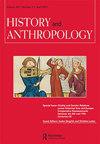运河过去:海上通道人类学
IF 0.4
2区 历史学
Q3 ANTHROPOLOGY
引用次数: 1
摘要
正常情况下,每天平均有50多艘船只通过苏伊士运河。通过亚洲和欧洲之间的连接点的旅程通常需要12到16个小时。然而,2021年3月23日将被证明是不同寻常的一天:一艘超大型集装箱船Ever Given在强风吹向一侧时停了下来,使其陷入狭窄水道的沙洲。“Ever Given”号由一家台湾航运公司运营,挂着巴拿马国旗,从中国大陆驶往荷兰鹿特丹,是此类事故中最严重的竞争者之一:它的载货能力高达20,000个20英尺的集装箱(teu),是世界上最大的集装箱船之一。事实上,尽管运河管理局做出了巨大的努力,但“永远给予”就是不动;在漫长的六天之后,打捞行动终于取得了成功,等待救援的船只已经超过300艘。与此同时,意外的运河阻塞给世界经济造成了估计每小时4亿美元的损失(Vlamis 2021)。在将这艘船从运河岸边释放的疯狂任务中,这艘船不仅使亚洲和欧洲之间的海上交通暂时停止。它还激发了公众对当代海上运输及其背后的全球历史的空前兴趣。为了将这些对话引导到人类学的领域,我们提出了一个短篇文集,重点关注海洋通道,它们的中断,以及伴随它们的多面人物。通道,在其最主要的意义上,指的是一条路径、运动或通道,这通常是,但并不总是,海洋的那种,正如沃尔特·本雅明对混凝土的反思,以及基于陆地的城市通道(即拱廊)也证明了这一点(本杰明2002)。其次,在比喻中,“the passage of time”指的是不可阻挡的分、日、年的流逝,它们被描绘成逐渐从我们身边流逝。“通过”的时间维度与我们关于苏伊士运河暂时关闭的争论同样相关。最后,一个段落可以指一个简短的作品,包括书面和音乐性质-一种浓缩的体裁,我们也希望在简短的干预中提出。运河的阻塞,以及它所受到的全球公众关注,代表了一个由事故转变成的非凡奇观。而大多数海上事故发生在室外本文章由计算机程序翻译,如有差异,请以英文原文为准。
Past the canal: An anthropology of maritime passages
On a normal day, an average of 50 + ships pass through the Suez Canal. The journey through this connecting point between Asia and Europe usually takes a vessel between 12and 16 h. The 23rd of March 2021, however, would prove to be a day out of the ordinary: the passage of the Ever Given, an ultra-large container ship, came to a halt when strong winds steered the vessel sideways, lodging it into the sandy banks of the narrowwaterway. Operated by a Taiwanese shipping company, sailing under the Panama flag, and on its way from China to Rotterdam in the Netherlands, the Ever Given was amongst the worst contenders for an accident of this kind: with a holding capacity of up to 20,000 twenty foot freight containers (TEUs), it ranks among the world’s largest container vessels. Indeed, despite the massive efforts made by the Canal Authority, the Ever Given would not move; with the queue of waiting ships growing to more than 300 by the time the salvage operation finally succeeded after six long days. In the meantime, the unexpected canal obstruction caused an estimated loss of 400 million US Dollars per hour to the world economy (Vlamis 2021). During the days of the frantic mission to release the ship from the Canal’s banks, the vessel had not only brought maritime traffic between Asia and Europe to a temporary halt. It also sparked unprecedented public interest in contemporary maritime transportation and the global histories behind it. In an effort to steer these conversations into anthropological terrain, we put forward a collection of short essays that focuses onmaritime passages, their interruptions, and on the multifaceted figures that accompany them. The passage, in its most dominant meaning, refers to a path, movement, or channel, which is often, but not always, of the oceanic kind, as the reflections ofWalter Benjamin on the concrete, and land-based urban Passagen (that is arcades) also attest to (Benjamin 2002). Secondly, in figurative speech, ‘the passage of time’ refers to the unstoppable elapsing of minutes, days, and years, which are pictured as gradually flowing away from us. This temporal dimension of ‘passage’ is equally as relevant to our argument around the Suez Canal’s temporary closure. And finally, a passage can refer to a brief composition, both of a written and musical nature – a condensed genre which we also aspire towards in the short interventions presented. The Canal’s obstruction, and the global public attention it received, represents an extraordinary accident-turned-spectacle. While most maritime accidents occur outside
求助全文
通过发布文献求助,成功后即可免费获取论文全文。
去求助
来源期刊

History and Anthropology
Multiple-
CiteScore
1.80
自引率
0.00%
发文量
41
期刊介绍:
History and Anthropology continues to address the intersection of history and social sciences, focusing on the interchange between anthropologically-informed history, historically-informed anthropology and the history of ethnographic and anthropological representation. It is now widely perceived that the formerly dominant ahistorical perspectives within anthropology severely restricted interpretation and analysis. Much recent work has therefore been concerned with social change and colonial history and the traditional problems such as symbolism, have been rethought in historical terms. History and Anthropology publishes articles which develop these concerns, and is particularly interested in linking new substantive analyses with critical perspectives on anthropological discourse.
 求助内容:
求助内容: 应助结果提醒方式:
应助结果提醒方式:


